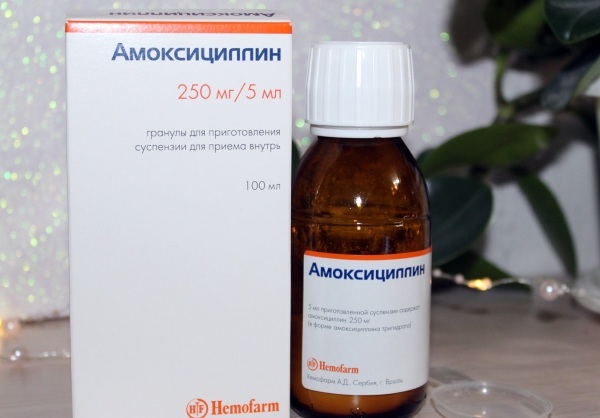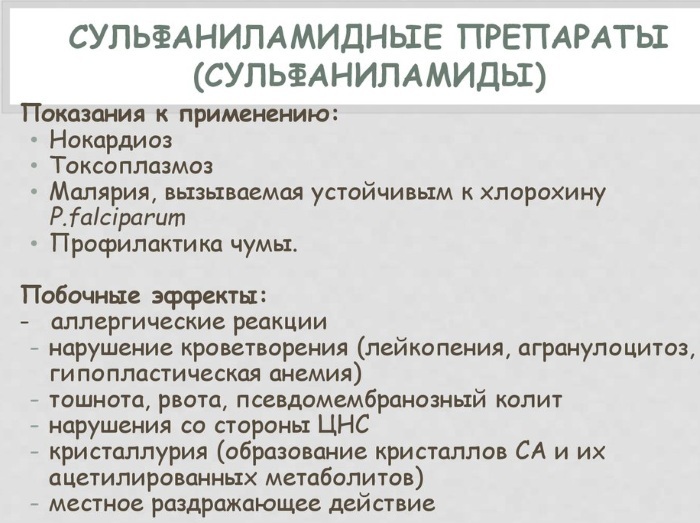Amoxicillin is one of the classic, but at the same time the most effective antimicrobial drugs. Its peculiarity is low toxicity, which makes it possible to prescribe it to children and women during pregnancy in any trimester.
The minimal effect of the drug on the fetus makes it possible to treat bacterial infections of various localization in cases where the danger to life and health exceeds the negative effect of the drug itself.
Record content:
- 1 Indications for use
- 2 Compound
-
3 In what form is it produced
- 3.1 Suspension granules
- 3.2 Capsules
- 3.3 Pills
- 4 Pharmacodynamics
- 5 Pharmacokinetics
- 6 Application for pregnant women
- 7 Contraindications
- 8 Overdose
- 9 Side effects
- 10 Drug interactions
- 11 Storage conditions and periods
- 12 Conditions of dispensing from pharmacies
-
13 Analogs
- 13.1 Augmentin
- 13.2 Ampicillin
- 13.3 Azithromycin
- 13.4 Suprax
- 14 Video about Amoxicillin
Indications for use
Amoxicillin, as a representative of the III generation of penicillin antibiotics, has a wide therapeutic spectrum and penetrates well into various tissues and liquid media. A particularly effective effect is observed in the genitourinary, bronchopulmonary systems and soft tissues. This semi-synthetic antibiotic is one of the most gentle drugs in its line.
The main indications for the appointment of Amoxicillin in pregnant women:
| Localization of infection | Diseases |
| ENT organs | Angina (streptococcal tonsillitis), sinusitis, external and internal otitis media, pharyngitis, tonsillitis |
| Respiratory system | Pharyngitis, bronchitis, pneumonia, tracheobronchitis |
| Genitourinary system | Severe cases of nonspecific vaginitis, urethritis, pyelonephritis, cystitis, adnexitis, gonorrhea |
| Zoonotic infections | Listeriosis, leptospirosis, borreliosis |
| Gastrointestinal organs | Ulcerative lesions with the release of Helicobacter pylori as a causative agent |
| Other systems and organs | Peritonitis, meningitis, cholangitis, endocarditis, various sepsis, mixed and unspecified infections |

Amoxicillin during pregnancy, the 1st trimester of which is marked by the detection of bacterial infection, is able to completely eliminate the infection, subject to the sensitivity of the pathogen. At the same time, appointments in the early stages are tried to be avoided in order to exclude the effect of the drug on the fetus. But sometimes bacteria pose a much greater danger to an unborn child than an antibiotic.
Compound
The active agent of the drug "Amoxicillin" is amoxicillin trihydrate - a semi-synthetic substance derived from ampicillin with a bactericidal effect.
The drug is capable of neutralizing a wide range of bacterial pathogens, is active against most gram + and gram pathogens. The exception is staphylococci, protected by b-lactamase, on which the third generation of penicillins does not act.
Compared to its predecessor ampicillin, the substance is better absorbed in the intestine, provides a double concentration in the blood and more actively penetrates the lung tissue. The activity of amoxicillin against susceptible pathogens is 5 times higher than that of previous generations of penicillins and ampicillin.
In what form is it produced
The antibiotic Amoxicilli with the active ingredient amoxicillin trihydrate is produced by many pharmaceutical companies around the world. The drug is currently available in three forms.
Suspension granules
White powder, packaged in 40 g glass vials with a sealed screw cap. When water (100 ml) is added and shaken vigorously, the preparation forms a sweet, fruity syrup that is easy to swallow.
The form of amoxicillin is recommended for children and can be prescribed by adults. During pregnancy, it is used for nausea and toxicosis, if it is impossible to swallow tablets due to the gag reflex.
The active ingredient of the drug is amoxicillin trihydrate. Additional ingredients to create a stable suspension are gum, sodium citrate and fruit flavors.
Together with the bottle in a cardboard box there is a measuring spoon for 5 ml of suspension. This dose contains 250 mg in terms of amoxicillin. The price of one package is 98 rubles.
Capsules
The most popular form of the drug when prescribed for adults. Yellow-green gelatin capsules contain yellowish-white powder of amoxicillin trihydrate, μ-cellulose and other excipients.
This form of the drug may contain 250 or 500 mg of the active ingredient. Capsules are packaged in cellular packages (8 or 10 pcs.) And cardboard boxes with 1, 2 or more blisters in each.
Dissolution of the gelatin capsule in the intestine provides a more complete adsorption of the drug and protects the stomach from its effects. Price per package with 16 tab. (250 mg) - no more than 80 rubles.
Pills
The traditional form of release for most antibacterial drugs. Amoxicillin tablets with a dosage of 250 or 500 mg can be coated or uncoated.
The drug is packaged in blisters of 10 pcs. and stacked in cardboard boxes with instructions attached. Coated tablets are recommended to be swallowed whole. Pills with a homogeneous structure can be chewed and crushed.
The cost of the drug varies widely depending on the manufacturer, the number of tablets and their dosage. The price of Amoxicillin starts at 37 rubles and can reach 400 rubles in some pharmacy chains.
Pharmacodynamics
Amoxicillin refers to antibiotics with bactericidal action. The substance disrupts the structure of the wall of the microorganism, which causes its death.
The activity of the antibiotic extends to streptococci, gonococci, pneumococci, staphylococci, klebsiella, escherichia, chlamydia and other pathogens. Resistance to amoxicillin is shown by some strains of staphylococci and streptococci, pseudomonas, enterobacteria, proteas, mycoplasmas.
Pharmacokinetics
The degree of bioavailability of amoxicillin is determined by its dose and does not depend on the fullness of the stomach. On average, the intestine absorbs up to 90% of the active substance.
After oral administration, the maximum presence of amoxicillin in the blood is detected after 2 hours, and the withdrawal period from the body exceeds 6 hours. Therefore, to achieve a therapeutic concentration in the tissues, it is sufficient to take the next dose of the drug every 8 hours.
By binding to plasma proteins, amoxicillin circulates in the blood and easily penetrates into all body fluids. It detects high concentrations in bile, bronchial secretions, middle ear fluid, urine.
If there is no inflammation in the meninges, the drug is practically not found in the cerebrospinal fluid. But the presence of foci of inflammation causes up to 20% of amoxicillin from the blood to be redirected to the cerebrospinal fluid.
Amoxicillin during pregnancy - the 2nd trimester and the last weeks before childbirth are considered the safest for the use of this antibiotic. Although teratogenic effects on the fetus in the early stages have also not been found, doctors prefer to avoid such prescription during the laying of the main organs of the child.
In trace amounts, amoxicillin crosses the placenta and is also found in breast milk in small doses.
Up to a quarter of all taken amoxicillin is metabolized to an inactive form, part of the substance destroyed by penicillinases (bacterial enzymes), and more than 60% is excreted through the kidneys and excreted with urine. Hemodialysis is effective in cleansing the blood of amoxicillin.
Application for pregnant women
The gestation period is not an absolute contraindication to treatment with amoxicillin. This antibiotic is one of the few that is successfully used at all stages of pregnancy. Limitations may be associated with individual reactions to the components of the drug or concomitant pathologies in a woman.
Amoxicillin during pregnancy (1 trimester) requires a special approach. The first 12 weeks after conception is the most vulnerable time for the embryo. Doctors try not to use any potent medications, and antibiotics are prescribed only if the condition threatens the life of the mother or fetus. Any drug treatment during this period is under the supervision of a specialist.
Justified is the use of amoxicillin at an early stage in acute genital infections, cystitis, threatening ascending infection. The drug is also shown for bacterial complications of viral diseases (pneumonia, bronchitis). At the discretion of the doctor, treatment can be prescribed for other dangerous conditions.
In the 2nd trimester, the laying of the main systems and organs of the fetus is completed, therefore, in conditions that do not threaten complications, they try to postpone therapy until this period.
The standard prescription of amoxicillin includes:
- a single dose of 250 to 500 mg, depending on the severity of the condition;
- taking with food or after meals;
- repetition of the dose every 8 hours;
- strict adherence to the duration of treatment.

A different cause of infection and its localization requires a different duration of therapy. In any case, treatment should be continued for at least 2 days from the moment the symptoms subsided. Some pathologies require continuous therapy for up to 12 days. The course of amoxicillin during pregnancy is calculated individually, taking into account all risks.
Amoxicillin during pregnancy (3rd trimester) often causes side effects. The load on the woman's body increases, which means that any chemical intervention is more difficult to tolerate. But since infection in the last weeks of gestation also poses a threat to the growing fetus, amoxicillin can be prescribed to stop the infection in a timely manner.
Antibiotic treatment for this period is carried out in a hospital setting, or it is recommended that a pregnant woman inform her doctor about any unexpected phenomena while taking amoxicillin.
Contraindications
The use of amoxicillin is absolutely excluded for women with previously identified intolerance to any of the antibiotics of the penicillin series. With caution, under the supervision of a doctor, the first doses of the medicine are carried out for a known allergy to cephalosporins. These two groups of drugs are most often cross-allergens.
Do not recommend taking in the presence of chronic damage to the kidneys, liver, bronchial asthma, gastrointestinal tract and vaginal dysbiosis, candidiasis. Pregnant women with systemic and progressive diseases are prescribed antibiotic therapy subject to medical supervision.
Overdose
A significant increase in the concentration of amoxicillin in the blood can occur for several reasons:
- If you accidentally take a large dose of the drug.
- After deliberately exceeding the recommended doses.
- In case of impaired renal function (as complications during pregnancy), which slows down the withdrawal of the drug from the body.
The maximum permissible daily dose of amoxicillin is 3 g of the drug. The danger of poisoning and organ damage was recorded after consuming 6 g / day.
The first symptoms of an overdose may be: upset stomach, headache, nausea and vomiting, intense thirst. With prolonged intoxication, dizziness, rash, pallor of the skin, tremors, and sometimes fainting appear. With such symptoms in a pregnant woman, urgent help from doctors is required - further absorption of the drug can lead to organ damage.
Side effects
Adverse events in the treatment of amoxicillin occur regardless of the form of the drug. Oral ingestion of syrup, capsules or tablets has the same effect on the body. During pregnancy, the manifestation of reactions that have not been observed previously with amoxicillin treatment is possible.
Possible side effects:
- Taking an antibiotic may be accompanied by allergic urticaria, itchy skin, runny nose, or conjunctivitis.
- From the side of the central nervous system, there are effects in the form of headache, insomnia, dizziness.
- On the part of the gastrointestinal tract, with prolonged use of amoxicillin, spastic pains, difficulty in digesting food, disruption of the intestines may appear: constipation or diarrhea.
In any case of manifestation of adverse reactions in a pregnant woman, you should consult your doctor about the possibility of dose adjustment or replacement of the drug.
Drug interactions
When taken simultaneously with amoxicillin, reactions with many pharmaceutical drugs are observed.
Tracked options for the interaction of amoxicillin:
- Synergism (mutual enhancement of influence) - any bactericidal antibiotics.
- Antagonism (mutual weakening of action) - with all bacteriostatic antibiotics.
- An increase in the concentration of amoxicillin - acetylsalicylic acid, phenylbutazone, oxyphenbutazone, sulfinpyrazone, probenecid.
- Increases the absorption of amoxicillin into the blood, while taking it with ascorbic acid.
- Joint reception increases the effect of indirect anticoagulants.
When taken against the background of treatment with methotrexate, the toxicity of the latter greatly increases. Any combination of potent substances, especially during pregnancy, should be discussed with your doctor.
Storage conditions and periods
The presence of various additional ingredients leads to the fact that Amoxicillin from different manufacturers has a different shelf life. The date of production, time of safe storage and the end date of use should be specified on the packaging of the specific product.
Estimated shelf life of various forms of Amoxicillin:
- tablets - 4 years:
- capsules - 3 years;
- granules (in a sealed bottle) - 4 years;
- ready-made suspension - no more than 2 weeks.
Amoxicillin retains its properties when stored in its original packaging without access to light at a temperature not exceeding +25 ° C. It is recommended to leave the drug out of the reach of children.
Conditions of dispensing from pharmacies
Medicines from the group of antibacterial agents are sold through pharmacy chains upon presentation of a prescription.
Analogs
Amoxil, containing the same active ingredient in similar dosages, can be considered a direct synonym for Amoxicillin. To enhance the effect of the antibiotic and expand its spectrum, combined preparations with the addition of clavulanic acid and other antimicrobial substances are used.
Penicillin antibiotics serve as a substitute for intolerance to the active substance. If an allergy to penicillins is detected, the replacement is carried out from the group of macrolides or other groups of antibiotics other than cephalosporins.
Augmentin
Combined preparation containing 250, 500 or 875 mg of amoxicillin and 125 mg of clavulanic acid (regardless of dosage) in one tablet. The additional substance protects the antibiotic from the destruction of resistant bacteria by b-lactamases, which increases the spectrum of action of amoxicillin.
Pregnant women are most often prescribed 1 tablet (375 mg) to be taken 2 times a day or a single dose at a dosage of 625 mg. With a severe course of infection, the number is doubled. The drug is well tolerated and rarely causes side effects. Indications, contraindications and drug interactions are similar to amoxicillin.
The price of Augmentin tablets with a minimum dosage starts at 180 rubles. Suspension (100 ml) costs 138 rubles. Pharmaceutical analogues Panklav and Flemoklav (soluble form of tablets) are distinguished by the same composition and slightly higher price.
Ampicillin
The precursor of amoxicillin has a wide range of effects, but is not capable of destroying staphylococci (including aureus). Its purpose during pregnancy is explained by the rare occurrence of adverse reactions (mainly allergic) and must be confirmed by the sensitivity of pathogens to it.
For the necessary therapeutic effect, ampicillin is drunk in the prescribed dosage (250 or 500 mg) every 6 hours. The usual course of drug therapy is from 5 to 7 days, but with some indications, the period of admission is increased to 2 weeks.
The clinical safety of the use of ampicillin for pregnant women has not been confirmed, but a long period of use the classical drug made it possible to trace its non-toxicity to the fetus and the absence of teratogenic effect on practice. The cost of packaging the drug (20 pcs.) In a dosage of 250 mg starts at 26 rubles.
Azithromycin
A representative of the macrolide group, often prescribed in different trimesters of pregnancy. The difference between the drug in a single dose per day and a short course of therapy. For the treatment of infections of the throat, nose, mouth and genitourinary system, a course of 2 to 5 days is sufficient. Azithromycin tablets are taken on an empty stomach. The duration of the course can only be determined by a doctor.
Its purpose during pregnancy is due to its ability to accumulate in tissues affected by infection (selectivity), without being distributed throughout the body in high concentrations. The penetration of the substance through the placenta is negligible.
The price of Azithromycin (500 mg) is about 200 rubles per package with 3 capsules.
Suprax
A cephalosporin antibiotic of the third generation with the active agent cfixime trihydrate. Despite similar indications for the appointment, Suprax is a more powerful drug and is used for more massive infections than amoxicillin.
The remedy in the 1st trimester of pregnancy and with a number of contraindications, including allergy to penicillins and cephalosporins, hepatic and renal pathologies, individual intolerance.
The antibiotic is prescribed for admission in acute conditions in pregnant women at 400 mg per day (can be divided into 2 doses of 200) for 7 or more days.
The cost of the drug (for 6 tablets) is about 600 rubles, the soluble form "solutab" (for 7 tablets) costs 100 rubles more. Suspension at a price reaches 900 rubles.
Amoxicillin is one of the most prescribed drugs for the treatment of bacterial lesions in pregnant women. An antibiotic, if necessary, can be used even in the 1st trimester. The safety of treatment with Amoxicillin during pregnancy has been tested by time and usually directly depends on following the doctor's instructions and strict adherence to dosages.
Video about Amoxicillin
Amoxicillin - instructions, contraindications, analogs:



